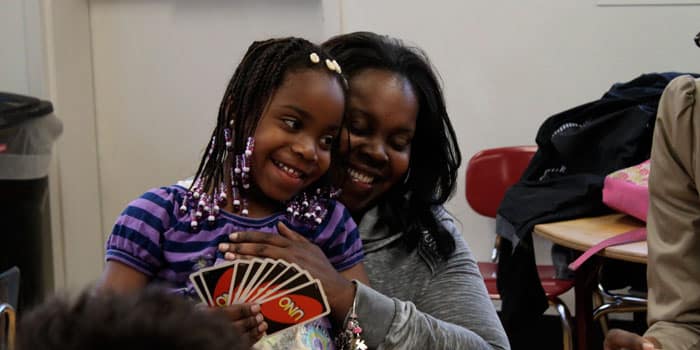One of our longtime instructors tells a story about an interaction with her daughter that happened early in her divorce. The instructor was angry and frustrated with her soon-to-be ex-husband. She had just ended a difficult phone conversation with him. She was brimming with emotion as she stood at the kitchen sink in tears. Her young daughter came into the room and asked her what was wrong. She told the girl, honestly but briefly, “I'm upset about your dad.” The daughter opened her arms and ran across the room to hug her mother saying, “I miss him too,” and burst into tears.
In this moment, parent and child were able to share comfort and connection, even though their feelings of upset had different beginnings and tones. Children need to share their feelings with us. They need our loving attention in order to feel safe enough to fully experience their often intense and sometimes frightening emotions. Human beings of all ages have a basic need to “feel felt.” We are social animals built to experience and share our lives with others like us. When the full range of our emotional experience is welcomed, we feel connected, whole and well.
 One thing we all know about emotions is that they rapidly change. (The word emotion comes from the French esmovoir “to set in motion, i.e., to move the feelings.”) Tempers can flare in an instant. And just as easily, an experience that made us furious when it happened becomes an amusing anecdote once we get a little distance from it. The classmate we couldn't stand in fifth grade becomes much more appealing as Senior Prom rolls around.
One thing we all know about emotions is that they rapidly change. (The word emotion comes from the French esmovoir “to set in motion, i.e., to move the feelings.”) Tempers can flare in an instant. And just as easily, an experience that made us furious when it happened becomes an amusing anecdote once we get a little distance from it. The classmate we couldn't stand in fifth grade becomes much more appealing as Senior Prom rolls around.
Our mood fluctuates like internal weather; sometimes our attitude is sunny, sometimes it is stormy, but it is always ready to flow into something else. Being stuck in one emotion is a sure sign that children need our loving attention in order to coax the natural process of emotional flexibility back into action. Our warm acceptance brings out the upset that is clogging the works and allows the child to feel felt as they share whatever rain needs to fall before their internal skies can be sunny again.
“Sounds easy on paper,” you say, “But how exactly do I do that?” Tomorrow, set aside some time to notice what your child is feeling. Do they wake up grumpy or delighted? Are they pleased they dressed themselves or dismayed that Special Time is over? Watch how they shift through a range of feelings over a short amount of time. Notice when feelings get “stuck,” or are carried from one situation into the next. Be aware of any tension building. When upset builds (which happens to all of us sooner or later), go to your child, make eye contact, touch him warmly and reassuringly, show your interest, and see what happens. As children take in your willingness to share emotional moments with them, they will increasingly accept your offers of connection to show you the feelings they carry, so they don't have to manage them alone.
As your child's built up feelings start to find expression, your job is to attend to these emotions. We call this Staylistening, and it's your key to helping your child feel felt. His emotions might be loud and they probably won't be pretty, but they are normal.
Listening to the feelings loosens their hold on your child. There's nothing you need to fix or change. Simply give your child your warm, caring attention. You don't need to agree that the emotions are warranted or feel responsible for redirecting your child into a different, more sensible response. Your child will feel felt whenever you can act as a generous and interested audience that is ready to share in the processing of these feelings. (His appreciation of your steadfast caring comes at the end of his emotional outburst, though–he can't manage to give you love or reassurance during the upset.) His great big feelings can then dissolve into the flow of feelings that move and change with your child through the day.
– Juli Idleman and Patty Wipfler
